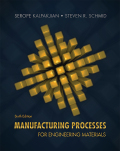
Concept explainers
Whether a part is forged or cast and the features should be investigated to arrive at a conclusion.
Explanation of Solution
In manufacturing industries, the forging is one of the oldest manufacturing processes. It is a process in which material is converted into the finished product through heating, cooling, and hammering process. Some forging process are cold forging, die forging, and warm forging.
Casting is also one of the oldest manufacturing processes in which the molten raw material is shaped into a desired finished product with the use of molds. Some types of casting process are sand casting, die casting, centrifugal casting, and many more. Similar parts are prepared by forging process and casting process.
Some parameters such as temperature, toughness, tensile strength, hardness, microstructure, and many more are used to found whether the part is forged or cast. The cast and forged parts have different temperatures. The tensile test is done to investigate the toughness of the part because the forged part has higher toughness. In forging, there is plastic deformation take place; hence the forged parts are smaller grain size compared to the casting process. The main investigation is roughness and characteristics of the surface. The forged product is nearly always heavier compared to the cast product.
Want to see more full solutions like this?
Chapter 6 Solutions
EBK MANUFACTURING PROCESSES FOR ENGINEE
- 1. A component is designed to be hot forged in an impression die. The projected area of the product is 5800 mm2. During the forging process flashing is formed so that the area including the flash will be 8900 mm2. The part geometry is considered to be simple and the heated work material yields at 92 MPa. Calculate the maximum force required to perform the operation. 2. What are the advantages and disadvantages to forge a product through the open forging process, rather than to machine it from the same material?arrow_forwardQ#3:(b) Explain the differences between Forward Extrusion and Reverse Extrusion processesarrow_forwardA piece with a height of 120 mm and a diameter of 75 mm can be increased to 80 mm in height by pile-forging.is reduced. The coefficient of friction between the workpiece and the mold is 0.13. Flow curve of the workpiece, 165It is defined by a strength coefficient of MPa and a hardening exponent of 0.24. force during operationCalculate at the moments given below and obtain the force-workpiece height graph(1) as soon as it reaches the yield point (yield strain = 0.002),(2) height h = 115 mm,(3) height h = 110 mm,(4) height h = 105mm,(5) height h = 100mm,(6) height h=95mm,(7) height h = 90 mm,(8) height h = 85mm,(9) height h = 80 mm,arrow_forward
- One way to define forging procedures is by the extent to which the work is constrained in the die. Explain this classification system by identifying the three primary classes.arrow_forwardWhat is the difference between drawing and extrusion?arrow_forwardWhat is the approximate yield strength of 250 maraging steel at room temperature? (No need to do a 0.2% offset, just estimate from the graph)arrow_forward
- Explain the open and closed mold forging processes with figures. Draw the force-stroke diagram in closed mold forging. Comment on the diagram.arrow_forwardWhat is the Forging process? Explain the process including two forged products.arrow_forwardA cold heading operation is performed to produce the head on a steel nail. The strength coefficient for this steel is 600 MPa, and the strain hardening exponent is 0.22. Coefficient of friction at the die‑work interface is 0.14. The wire stock out of which the nail is made is 5.00 mm in diameter. The head is to have a diameter of 9.5 mm and a thickness of 1.6 mm. The final length of the nail is 120 mm. (a) What length of stock must project out of the die in order to provide sufficient volume of material for this upsetting operation? (b) Compute the maximum force that the punch must apply to form the head in this open‑die operation.arrow_forward
- A cylindrical part is warm upset forged in an open die. The initial diameter is 50 mm and the initial height is 40 mm. The height after forging is 30 mm. The coefficient of friction at the die-work interface is 0.25. The yield strength of the work material is 285 MPa, and its flow curve is defined by a strength coefficient of 600 MPa and a strain-hardening exponent of 0.12. Calculate the strain at yield point.arrow_forwardAn austenitic stainless steel plate with a width of 100 mm, a length of 150 mm and a thickness of 50 mm is to be hot forged in a hydraulic press so that the width remains constant. If it is to be reduced in one step to a thickness of 40 mm, calculatea) the actual load that needs to be applied at the end of the forging, as well as b) the corresponding deformation energy. In previous plane strain compression tests, it was found that the material exhibits an average plane strain yield stress of 80 MPa at the forging temperature. Assume that the efficiency of the process is 0.6 Answer: Pfr= 2.5 MN ; WTr= 25 kJarrow_forwardA upset forging operation is performed in an open die. The initial size of the workpart is: Do = 63 mm, and ho = 100 mm. The part is upset to a diameter = 70 mm. The work metal has a flow curve with strength coefficient = 600 MPa and strain hardening exponent= 0.22. Coefficient of friction at the die-work interface = 0.40. Determine (a) final height of the part, and (b) maximum force in the operationarrow_forward
 Welding: Principles and Applications (MindTap Cou...Mechanical EngineeringISBN:9781305494695Author:Larry JeffusPublisher:Cengage Learning
Welding: Principles and Applications (MindTap Cou...Mechanical EngineeringISBN:9781305494695Author:Larry JeffusPublisher:Cengage Learning
